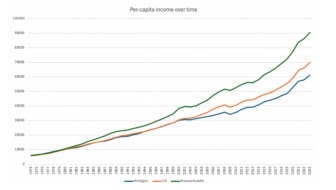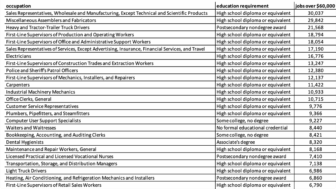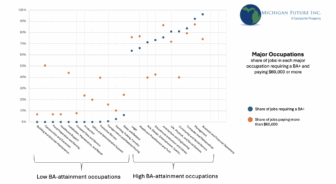
Our analysis of the robust 2019 Michigan labor market makes clear that Michigan has a two-tier economy. Nearly six in ten Michigan payroll jobs pay less than what is required for a family of three to be middle class ($47,000). This two-tier economy is prevalent across all of Michigan and across all races and ethnicities. This two-tier economy is structural. A reality when the Michigan economy is expanding as well as when it is contracting.
The Michigan Future, Inc. Board is committed to having a market economy that as it grows benefits all. We need a Michigan economy that provides family-sustaining jobs––not just any job––so that all working Michigan households can raise a family and pass on a better opportunity to their children.
We believed before the onset of the pandemic––and even more so now––that now is the time to make fundamental change in the state’s playbook to increase the economic well-being of all Michiganders. To identify the state policy levers that can have the highest impact on ending Michigan’s two-tier economy. And then go big in pivoting to a new approach to building a market economy that as it grows benefits all. Starting with a big expansion of Michigan’s Earned Income Tax Credit (EITC).
The EITC is pro work and an incentive to go back to work. The pandemic made clear that low-wage workers live paycheck to paycheck not because they are irresponsibly buying “unnecessary” luxuries, but because they are in low-wage jobs that leave them struggling to pay for the necessities. The reality is that most of those struggling economically, in good times and bad, are hard-working Michiganders who like us get up every day and work hard to earn a living. What these lower-wage workers need most is income, not programs.
Conservative Origins
The EITC origins come from conservatives. Starting with Milton Friedman calling for a negative income tax in his 1962 book Capitalism and Freedom. The Earned Income Tax Credit was signed into law by President Gerald Ford in 1975. Ford explicitly designed the credit to encourage greater participation in the workforce. President Ronald Reagan expanded the EITC. Paul Ryan, an EITC supporter, proposed a big expansion of the credit for workers without children.
Encouraging Working
The EITC is explicitly designed to encourage greater participation in the workforce. It is available only to families that work. The credit is designed to encourage individuals to enter the labor market. In a time when many employers are having difficulty filling available jobs, the EITC has a proven track record of pulling people into the workforce.
Increasing Local Purchasing Power
The EITC provides income to be spent in the local economy. The bigger the credit the more money spent locally. Research indicates that families mostly use the EITC to pay for necessities, repair homes, maintain vehicles that are needed to commute to work, and in some cases, obtain additional education or training to boost their employability and earning power.
Federal EITC basics
The EITC is a policy designed to bolster the earnings of low-wage workers and offset some of the taxes they pay, providing the opportunity for struggling families to step up and out of poverty toward meaningful economic security. To encourage greater participation in the workforce, the EITC is based on earned income, such as salaries and wages. When filing taxes for 2019, working families with children that have annual incomes below about $41,100 to $56,000 (depending on marital status and the number of dependent children) were eligible for the federal EITC. Also, working-poor people who have no children and have incomes below $15,570 ($21,370 for a married couple) can receive a very small EITC.
The amount of EITC depends on a recipient’s income, marital status, and number of children. Workers receive the credit beginning with their first dollar of earned income; the amount of the credit rises with earned income until it reaches a maximum level and then begins to phase out at higher income levels. The EITC is “refundable,” which means that if it exceeds a low-wage worker’s income tax liability, the IRS will refund the balance.
During the 2017 tax year, the average EITC was $3,191 for a family with children (boosting wages by about $266 a month), compared with just $298 for a family without children. The federal EITC for childless individuals was expanded in 2021 for one year only as part of the American Rescue Plan.
State EITC Basics
Michigan enacted a state EITC in 2006 at 20% of the federal credit. In 2011 Michigan’s Earned Income Tax Credit was reduced to 6% of the federal credit. In 2019, 738,000 Michigan households received the state EITC with an average benefit of $150. At a cost of $111 million.
State EITCs are easy for states to administer and for working families to claim. States incur virtually no costs for determining eligibility for the credit because, in most cases, families eligible for the federal credit also are eligible for the state credit. Since state credits typically are set at a fixed percentage of the federal credit, state revenue departments need only add one line to a state’s income tax form, and filers need only multiply their federal EITC by a specified rate to determine their state credit.
30 states plus D.C. offer state EITCs. Current state EITC policies are mostly modeled after the federal credit. State EITC eligibility requirements often closely match federal requirements. Similarly, most states calculate their EITCs as a simple percentage of the federal credit.
The credit in Michigan and all but six states, like the federal credit, are refundable. Of the states with refundable credits and a match for the federal credit, Michigan has the fourth lowest match. The highest match is 85 percent in California but only for very low-income earners. Of the states with a match for all federal EITC eligible households Maryland currently has the highest match at 45 percent. D.C. has the highest match for childless households at 100 percent.
Our Recommendation
We believe expanding Michigan’s Earned Income Tax Credit is the best way for the state to support the too many hard-working Michiganders who are struggling economically. The best way towards creating a post-pandemic market economy that as it grows benefits all.
The EITC is a proven way to combat a two-tier economy, boost local economies and pull people into the workforce. And all of this can be done with little or no additional administrative costs. Now is the time for Michigan to move from the bottom to the top of states with an Earned Income Tax Credit.







